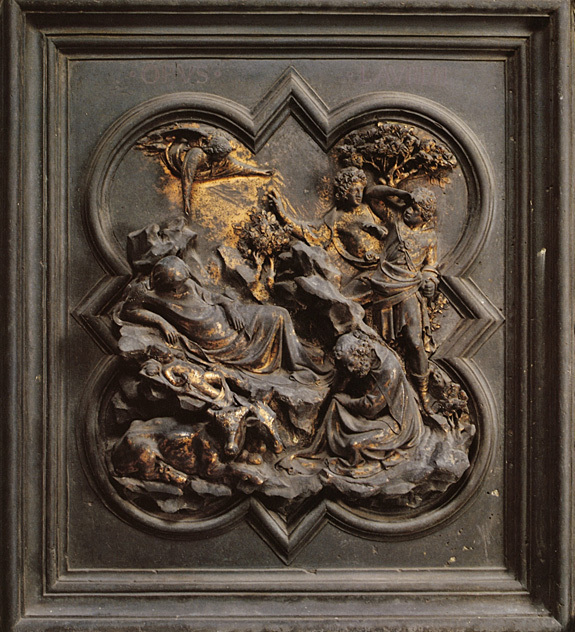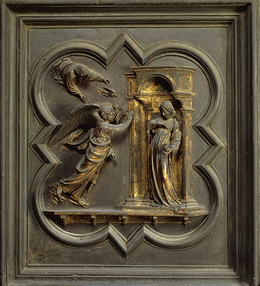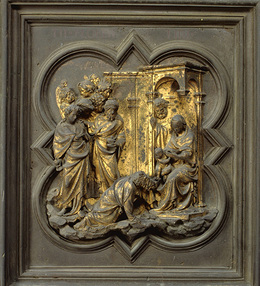Panel II - The Nativity
Panel details:
Luke, 2:10-12: “then the angel said to them, “do not be afraid, for behold, I bring you good tidings of great joy which will be to all people. For there is born to you this day in the city of David a saviour, who is Christ the Lord. And this will be the sign to you: you will find a babe wrapped in swaddling cloths, lying in a manger.”
The birth of Jesus characterized the most intensely awaited event in antiquity. The Hebrew scriptures had promised his birth would signify the coming of the messiah, the son of God, the saviour of mankind, the watershed of everything that occurred in history before and after the event. Jesus represented the turning point in the history of mankind, from that moment forward influencing all the events revolving around Christianity. Two of the four canonical gospels as well as the protevangelium of James and the gospel of pseudo-Matthew narrate the story of the birth of Jesus in meticulous detail. The apocryphal gospels, which were written at a later date, narrate the stories and legends surrounding the birth of Jesus in a Magical–fable like style. The historical value of these texts is limited, albeit some parts may have been based on historical facts. For instance, the apocryphal gospels described the birth of Jesus as a flash of light and the place of birth is a cave in Bethlehem instead of a stable as Luke had suggested. In Palestine the typical landscape was comprised of numerous small caves utilized as storerooms or small stables adjoined to the simple homes of the shepherds and farmers. Joseph was traveling to the city of Bethlehem with his family to comply with the census and probably found hospitality in a house with an adjoining cave the owners used as a stable and storeroom. Jewish law forbade childbirth in the house, because the woman was considered unclean due to the loss of blood; thus, it is plausible that Mary found lodging in a cave. This particular detail is not mentioned in the canonical gospels, though over time it has become an important element in the representation of the nativity scene. Moreover, the architecture of the church of the nativity confirms this tradition. This detail, then, is not necessarily to be considered the antithesis of the widespread popular tradition of the nativity that st Luke had indicated occurring in a stable. The gospel of pseudo-Matthew, dated 8th - 9th century, adapted the tradition of the cave mentioned in the protevangelium of James to that of the stable in the canonical gospels. Mary gave birth to the child in a cave in Bethlehem; then, on the third day the family moved to a stable where the donkey and the ox were located. These two animals are a recurring element in artistic representations of the nativity and the nativity scene, and quite probably originated from specific passages in the Old Testament (Isaiah 1:3; Habakkuk 3:2; Exodus 25:18 to 20), which Isaiah mentions clearly: “the ox knows its master and the donkey his master’s crib, but Israel does not know, my people do not consider” (Isaiah 1:3). The two animals represent mankind that initially was not able to comprehend the significance of the poverty of the birth of the child, until realizing they were in the presence of God in the humble stable, thereby arriving at the epiphany that imparts understanding to the world. Christian iconography realized the importance of the scene and no representation of the nativity scene has ever renounced to including the ox and the donkey.
There is much debate concerning the historical authenticity of the gospel stories regarding the nativity. Matthew and Luke both agree on a few points, which we shall briefly list: Jesus’ parents, Joseph and Mary, were engaged but not married when Mary became pregnant; in both gospels an angel announces the birth of Jesus; Matthew narrates that the angel made the announcement to Joseph, Luke instead to Mary; the child was conceived by divine intervention; an angel declares that his name will be Jesus, and that he will be the saviour; the birth takes place at the time of Herod the great; Jesus spent his teenage years in Nazareth. The discrepancies in the gospels of Luke and Matthew’s versions of the nativity represent their two different catechetical obligations. The early Christian communities that followed Matthew were primarily Jews, which is why the author would not have mentioned details like the census, as it was not important to the Jews. The gospel of Luke instead was addressed to the gentiles, which is why, especially in the story of the nativity, there are some references to the present day, such as the census Augustus decreed that the community fully understood and accepted; on the contrary, Matthew’s citations from the old testament would have been totally obscure to them.
According to traditional interpretation, even the most disputed historic elements, such as the star appearing and the birth occurring at the time of the census of Quirinius, could possibly be authentic. The phenomenon of the star (traditionally and improperly called comet) the Magi saw and interpreted as the announcement of the birth of the “king of the Jews”, dates back to the analysis of kepler who identified it as the triple conjunction of Jupiter and Saturn in the constellation of pisces, occurring in 7 bC. The birth of Jesus is typically chronologically placed during the reign of Herod (who probably died in 4 bC), as well as during the census of Quirinius. In truth, there is no conflict concerning the historic authenticity of the nativity taking place during the census of Quirinius and the nativity at the time of Herod. Historically, there were two censuses: the “first” decreed by Augustus around 8 bC and the “second” was organized by the governor Quirinius in 6 ad as the historian Flavius Josephe referred.
The liturgical feast of Christmas celebrating the anniversary of the birth of Jesus was formally established and documented in Rome in 336 and can be verified in the chronographus, drawn up in the mid-fourth century by the Roman writer Furio Dionysus Philocalus. The majority of historians agree that the date 25 December has practical as well as symbolic motivations. The new Christian beliefs had been inserted in the calendar along with Roman traditions, thus placing the commemoration of the nativity of Christ during the ancient winter festivals dedicated to Saturn, perhaps because these feasts marked the end of a season, while the main purpose was the temporary abolition of social differences, including reversing the roles of slaves and masters. Numerous historians maintain the date 25 December would be in conflict with the episode of the adoration of the shepherds mentioned in the gospel of Luke, which narrates the shepherds spent the night in the fields keeping watch over their flock. This occurred in the period of the feast of the passover; that is, between March and October, not in the winter, because it would have been too cold to spend the night in the fields. Further, observing the phenomenon of the star mentioned in the gospel according to Matthew, could have been in May, October and December. Comparing the gospel description with the astronomical phenomenon, many scholars consider it plausible that the Magi began their journey in the month of May (at the beginning of the phenomenon) arriving at their destination in October. Thus, Jesus would have been born in September, which is consistent with the shepherds sleeping in the fields at night. It took quite a long time to replace the pagan feast, as confirmed by the fact that pope Leo the great strongly admonished those “to whom this our solemn feast day seems to derive its honour, not so much from the nativity of Christ as, according to them, from the rising of the new sun”. According to Jewish tradition, the 25th day of the month of Kislev, corresponding to our December, is the celebration of the Jewish feast of light, Hanukkah. Many scholars believe that the celebration of the birth of Jesus on 25 December is connected to this Jewish holiday, which would signify that Christianity adopted yet another Jewish holiday to celebrate Christmas as it had for Easter and Pentecost, which coincide with Jewish holidays.
Several analyses confirm the authenticity of the liturgical version of the nativity taking place on 25 December, starting with the Winter solstice. Polytheistic cultures celebrated Sol invictus on 21 December and not on the 25th, although it is worth pointing out that the early church especially in the east, had set the date of the birth of Jesus on 25 December within the first few years after his death. The date had been ascertained from studies of the early Judeo-Christian traditions, derived from the circle of the family of Jesus; that is, the original church of Jerusalem and Palestine, which proved authentic upon examination by contemporary historians. Today, we are in possession of documentary and archaeological evidence confirming the venerable tradition of the Church. the sacred texts of Qumran (found in 1947, dating between 1st and 2nd century A.D.) which the dead sea monks have safeguarded, contain documents of the Book of Jubilees, dating back to the second century bC and which after nearly two millennia has allowed us to finally identify the dates the Jewish clerical classes officiated in the temple of Jerusalem. The text refers to the Abijah class (the eighth of the twenty-four classes officiating in the temple), to which Zacharias, father of John the Baptist, belonged and who went to the temple in the week between 23 and 30 September. Considering Zacharias entered the temple on 23 September, the day indicated in the gospel of Luke in which he received the announcement from archangel Gabriel of the birth of his son John, the precursor of the Lord, he might have been born around 24 June, about nine months after the annunciation. The gospel emphasizes this six-month difference between the births of John and Jesus. It logically follows that had Jesus been conceived on 25 march, it is correct to commemorate his birth on 25 December, allowing for a minimal approximation. The liturgical celebrations of conceptions and days of birth of John and especially of Jesus, proved compatible with the archaeological discovery of the Judean desert. Even the question of the shepherds that could not have spent the night with their flocks during the Winter may be rebutted. An in-depth analysis demonstrates that the communities of Jewish shepherds distinguished three kinds of herds, depending on the type of wool. Only black wool flocks were considered impure and were not allowed to be brought into the city, therefore it would seem possible that the shepherds were in Bethlehem in the Winter guarding their flocks when the angels made their announcement. Augustine of Hippo accepts the date of 25 December in his allegorical interpretation, commenting on John 3:30, “Christ was born when the days begin to increase [25 December], John was born when the days begin to decrease [24June]”; “it was indeed fitting that the day on which all temporal creation was in peace and harmony should be the birthday of the eternal creator now created in time”.
The iconography of the event has been developed according to the topics of Jesus wrapped in swaddling clothes, the manger, Joseph, Mary, the ox and the donkey, the cave-stable, the shepherds, as well as the angel announcing the birth of the messiah to the shepherds. The angel of the Lord appears to the shepherds and the glory of the Lord envelops them in light. “and behold, an angel of the Lord stood before them, and the glory of the Lord shone around them, and they were greatly afraid.” (Luke 2:9). “and this will be the sign to you: you will find a babe wrapped in swaddling cloths, lying in a manger”. “and suddenly there was with the angel a multitude of the heavenly host praising God and saying: “glory to God in the highest, and on earth peace, goodwill toward men!” (Luke 2:12 to 14 ).
The earliest representations of the nativity date to the third century. The frescoes in the catacombs depict the scene in symbolic style to avoid anything that might suggest idolatry or worship of idols. On the coverings of some sarcophagi dating to the fourth century, the central image of Jesus together with the two animals is sometimes accompanied by one or two shepherds wearing the short Roman tunic tied at the waist, heads bare and holding a curved-top staff, or a rophet holding a scroll. Mary appears in the scene, sitting on a rock on the side only when the scene is associated to the adoration of the Magi and the star. Starting in the fifth century, the prophet and often the shepherd disappear while Joseph is depicted sitting on a rock on the opposite side to Mary. In the sixth century Mary becomes the second focal point of the composition. The true representation of the nativity was canonized in the fifth century, appearing after the Council of Ephesus in 431. On that occasion the divine motherhood of Mary was proclaimed and this theme was represented from that date forward. Most works of art depict Mary in a lying position, as in byzantine art. The manger that Luke mentioned as a sign to recognize the child, was often replaced with a table, a chest or a wicker basket. The origin of the latter could possibly be attributed to the story of Moses found in a basket in the water. the variant of the table, usually covered with a cloth, very probably represents an altar. The holy family is represented either inside or in the vicinity of a stable or a cave. the child is often depicted lying in the middle between the ox and the donkey, whilst Mary and Joseph watch over him. The scene is sometimes enriched by the presence of saints and donors (developed particularly during the Florentine Renaissance) and architectural details enfolding the figures within a domestic environment.
Ghiberti created the panel depicting the nativity on the North Door of the Baptistery in Florence in the early stage of his work, which can be observed by the similarities in its spatial and stylistic composition to the panel of the competition dated 1401, as Krautheimer indicated in his studies (1937.1956).
The composition occupies the entire space of the quatrefoil frame functioning as a window through which we may observe the event. An imaginary diagonal line drawn from right to left divides the tile into two areas.
The nativity of Jesus is represented according to ancient canonical tradition. The holy family is in a resting position, Joseph is crouched down and pensive, at the same time expressing the suffering of the ‘’just man” and the difficulties all men experience trying to comprehend the impenetrable mystery of the incarnation. On the bottom right side of the panel, the ox and the donkey are kneeling down in a resting position; on the left there are the figures of two shepherds, with expressions of amazement and fear listening to the angel’s announcement. The two parts of the panel simultaneously narrate a dual, conflicting temporal and spatial event.
On one side of the panel the holy family radiates calmness as well as a physical and spiritual stillness contrasting with the dynamism of the shepherds and angels. The entire composition is organized in a naturalistic manner through the positioning of the figures as well as in the details of the scenery. The rocks and trees are depicted in ample and careful detail, in the style Ghiberti adopted that can be observed on all the panels of the North Door. The sleeping Virgin evokes the Madonna sculpted by Arnolfo, set in one of the portals on the facade of the Duomo, whilst the artist sculpted the draperies of the figures in traditional late Gothic style. Ghiberti’s composition emanates a new narrative, observing classic naturalistic references while simultaneously achieving a pre-Renaissance masterpiece.



